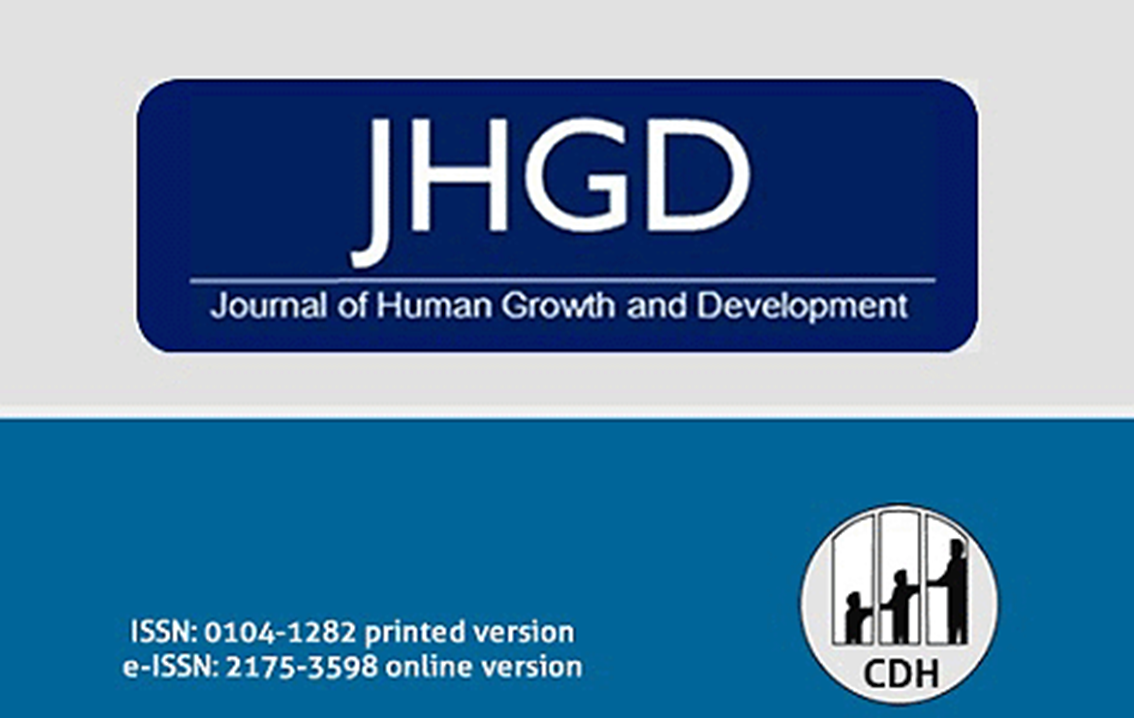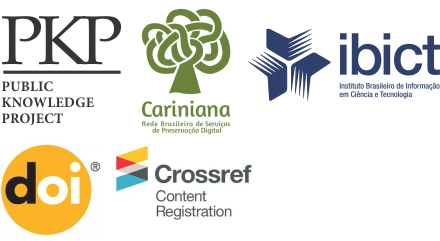New trends in instruments for child development screening in Brazil: a systematic review
DOI:
https://doi.org/10.7322/jhgd.v30.10366Keywords:
Child development, Screening instruments, Surveillance, Development evaluation, Systematic reviewAbstract
Introduction: Screening instruments are widely used to monitor child development. The accurate use of standardized tools is an indispensable condition for clinical practice and research aimed at detecting developmental risks and other problems in children.
Objective: The objective of this systematic review was to analyze the use of standardized tools for child development screening used in studies with Brazilian children.
Methods: Two independent researchers selected references in English and Portuguese from five databases through which they searched for studies that used screening tests to assess the development of Brazilian children. All articles were read to determine the main objective, design, target population, the type of screening test, and the purpose of using the test with Brazilian children.
Results: Among the 27 papers analyzed, most of them was observational studies conducted with children up to six years of age, with the main objective to screen development delays and analyze associations between risks and child development. Four instruments were identified: Denver Developmental Screening Test II, Ages and Stages Questionnaire, Bayley Scales of Infant and Toddler Development Screening Test, and Battelle Developmental Inventory Screening Test. Three of these tests have been validated for use in Brazil.
Conclusion: This review suggests that the screening instruments have been used in research for different purposes, such as in the diagnosis of developmental problems, and sometimes inappropriately. Furthermore, studies to validate measures for screening and assessing the development of Brazilian children are still scarce and, therefore, deserve more attention.
Downloads
References
2. Figueiras AC, Souza ICN, Rios VG, Benguigui Y. Manual para vigilância do Desenvolvimento Infantil no contexto da AIDPI. Washington: Organizacão Pan-Americana de Saúde, 2005.
3. Brasil. Ministério da Saúde. Política Nacional de Atenção Integral à Saúde da Criança: orientações para implementação. Brasília: Ministério da Saúde, 2018.
4. Zeppone SC, Volpon LC, Del Ciampo LA. Monitoramento do desenvolvimento infantil realizado no Brasil. Rev Paul Pediatr. 2012;30(4):594-9. DOI: http://dx.doi.org/10.1590/S0103-05822012000400019
5. Glascoe FP. Early detection of developmental and behavioral problems. Pediatr Rev. 2000;21(8):272-80. DOI: https://doi.org/10.1542/pir.21-8-272
6. Mancini MC, Almeida KM, Brandão MB, Drummond AF. Avaliação do Desenvolvimento Infantil. In: Miranda L, Amaral J, Brasil T. Desenvolvimento da criança em risco neuropsicomotor. Fortaleza: Expressão Gráfica, 2012.
7. Richardson PK. Use of standardized tests in pediatric practice. In: Case-Smith J, O’Brien JC. Occupational Therapy for Children. St Louis: Mosby, 2010; p. 216-43.
8. Rocha SR, Dornelas LF, Magalhães LC. Instrumentos utilizados para avaliação do desenvolvimento de recém-nascidos pré-termo no Brasil: revisão da literatura. Cad Ter Ocup UFSCar. 2013;21(1):109-17. DOI: http://dx.doi.org/10.4322/cto.2013.015
9. Moreira RS, Figueiredo EM. Instruments of assessment for first two years of life of infant. J Hum Growth Dev. 2013;23(2):215-21. DOI: https://doi.org/10.7322/jhgd.61309
10. Santos RS, Araújo APQC, Porto MAS. Early diagnosis of abnormal development of preterm newborns: assessment instruments. J Pediatr (Rio J). 2008;84(4):289-99. DOI: http://dx.doi.org/10.1590/S0021-75572008000400003
11. Wehby GL, Trujillo AJ. Differences in Early Cognitive and Receptive-Expressive Neurodevelopment by Ancestry and Underlying Pathways in Brazil and Argentina. Infant Behav Dev. 2017;46(12):100-14. DOI: https://doi.org/10.1016/j.infbeh.2016.12.001
12. Silva ACD, Engstron EM, Miranda CT. Fatores associados ao desenvolvimento neuropsicomotor em crianças de 6-18 meses de vida inseridas em creches públicas do Município de João Pessoa, Paraíba, Brasil. Cad Saude Publica. 2015;31(9):1881-93. DOI: http://dx.doi.org/10.1590/0102-311X00104814
13. Satterfield-Nash A, Kotzky K, Allen J, Bertolli J, Moore CA, Pereira IO, et al. Health and Development at Age 19–24 Months of 19 Children Who Were Born with Microcephaly and Laboratory Evidence of Congenital Zika Virus Infection During the 2015 Zika Virus Outbreak — Brazil, 2017. MMWR Morb Mortal Wkly Rep. 2017;66(49):1347-51. DOI: http://doi.org/10.15585/mmwr.mm6649a2
14. Karam SM, Barros AJ, Matijasevich A, Santos IS, Anselmi L, Barros F, et al. Intellectual Disability in a Birth Cohort: Prevalence, Etiology, and Determinants at the Age of 4 Years. Public Health Genomics. 2016;19(5):290-7. DOI: http://doi.org/10.1159/000448912
15. Brentani A, Fink G. Maternal depression and child development: Evidence from São Paulo’s Western Region Cohort Study. Rev Assoc Med Bras. 2016;62(6):524-9. DOI: http://dx.doi.org/10.1590/1806-9282.62.06.524
16. Campos D, Arias AV, Campos-Zanelli TM, Souza DS, Santos Neto OG, Peralta CFA, et al. Twin-twin transfusion syndrome: neurodevelopment of infants treated with laser surgery. Arq Neuropsiquiatr. 2016;74(4):307-13. DOI: http://dx.doi.org/10.1590/0004-282X20160032
17. Domingues MR, Matijasevich A, Barros AJD, Santos IS, Horta BL, Hallal PC. Physical Activity during Pregnancy and Offspring Neurodevelopment and IQ in the First 4 Years of Life. Chen A. PLoS One. 2014; 9(10):e110050. DOI: http://doi.org/10.1371/journal.pone.0110050
18. Guerreiro TBF, Cavalcante LIC, Costa EF, Valente MDR. Triagem do Desenvolvimento Neuropsicomotor de Crianças das Unidades de Educação Infantil do Município de Belém, Pará, Brasil. J Hum Growth Dev. 2016;26(2):181-9. DOI: http://dx.doi.org/10.7322/jhgd.119262
19. Santana CMT, Figueiras A, Landeira-Fernandez J. Ages & Stages Questionnaire-Brazil-2011: Adjustments on an Early Childhood Development Screening Measure. Glob Pediatr Heal. 2015;2. DOI: http://doi.org/10.1177/2333794X15610038
20. Costa EF, Cavalcante LIC, Silva ML, Guerreiro TBF. Association between family poverty and the neuropsychomotor development of children in the administrative districts of Belém. Fisioter Mov. 2016;29(3):533-42. DOI: https://doi.org/10.1590/1980-5918.029.003.AO11
21. Coelho R, Ferreira JP, Sukiennik R, Halpern R. Child development in primary care: a surveillance proposal. J Pediatr (Rio J). 2016;92(5):505-11. DOI: https://doi.org/10.1016/j.jped.2015.12.006
22. Pinto FC A, Isotani SM, Sabates AL, Perissinoto J. Denver II: comportamentos propostos comparados aos de crianças paulistanas. Rev CEFAC. 2015;17(4):1262-9. DOI: https://doi.org/10.1590/1982-0216201517418214
23. Cruz EJS, Dias GB, Pedroso JS. Estudo do “Ages and Stages Questionnaires” com cuidadores de crianças institucionalizadas. Psico-USF. 2014;19(3):411-20. DOI: https://doi.org/10.1590/1413-82712014019003004
24. Oliveira AC, César CPHAR, Matos GG, Passos PS, Pereira LD, Alves T, et al. Habilidades auditivas, de linguagem , motoras e sociais no desenvolvimento infantil?: uma proposta de triagem. Rev CEFAC. 2018;20(2):218-27. DOI: https://doi.org/10.1590/1982-0216201820216617
25. Costa EF, Cavalcante LIC, Dell’Aglio DD. Perfil do Desenvolvimento da Linguagem de crianças no Município de Belém, segundo o Teste de Triagem de Denver II. Rev CEFAC. 2015;17(4):1090-102. DOI: http://dx.doi.org/10.1590/1982-0216201517418514
26. Fink G, Andrews KG, Brentani H, Grisi S, Ferrer APS, Brentani A. Overall and sex-specific associations between fetal adversity and child development at age 1 year: evidence from Brazil. Am J Epidemiol. 2018;187(11):2324-31. DOI: http://doi.org/10.1093/aje/kwy141
27. Silva ML, Cavalcante LIC, Heumann S, Lima TVR. Relação entre gênero e desempenho neuropsicomotor de crianças em Belém, Brasil. Ciênc Saúde Coletiva. 2018;23(8):2721-30. DOI: https://doi.org/10.1590/1413-81232018238.13202016
28. Mezzari SS, Donadio MVF, Gerzson LR, Almeida CS. Desenvolvimento neuropsicomotor e desnutrição de uma população de risco de um bairro de Porto Alegre. Medicina (Ribeirão Preto). 2019;52(2):80-90. DOI: http://dx.doi.org/10.11606/issn.2176-7262.v52i2p80-90
29. Mello PRB, Caldas CSO, Souza SC, Silva AMC. Concordância entre dois testes de triagem na avaliação da linguagem em crianças nascidas prematuras e de baixo peso. Rev Bras Saúde Matern Infant. 2016;16(3):303-11. DOI: https://doi.org/10.1590/1806-93042016000300005
30. Mari MA, Cascudo MM, Alchieri JC. Congenital Heart Disease and Impacts on Child Development. Braz J Cardiovasc Surg. 2016;31(1):31-7. DOI: https://doi.org/10.5935/1678-9741.20160001
31. Silva TM, Bueno NB, Azevedo MLSG, Clemente APG, Florêncio TMMT. Desempenho cognitivo de pré-escolares com baixa estatura em tratamento de recuperação nutricional. Rev Paul Pediatr. 2018;36(1):39-44. DOI: http://dx.doi.org/10.1590/1984-0462/;2018;36;1;00007
32. Frezzato RC, Santos DCC, Goto MMF, Ouro MPC, Taddeo C, Santos M, et al. Habilidade motora fina e linguagem expressiva em crianças com hipotireoidismo congênito. CoDAS. 2017;29(1):e20160064. DOI: http://doi.org/10.1590/2317-1782/20172016064
33. Dell’Agnolo CM, Cyr C, Montigny F, Barros Carvalho MD, Pelloso SM. Pregnancy after Bariatric Surgery: Obstetric and Perinatal Outcomes and the Growth and Development of Children. Obes Surg. 2015;25(11):2030-9. DOI: http://doi.org/10.1007/s11695-015-1668-9
34. Arias AV, Campos D, Campos-Zanelli TM, Souza DS, Peralta CFA, Guerreiro MM. Síndrome de transfusão feto-fetal: Teste de triagem do desenvolvimento neurológico. Arq Neuropsiquiatr. 2015;73(3):194-9. DOI: https://doi.org/10.1590/0004-282X20140237
35. Cavalheiro MG, Lamônica DAC, Hage SRV, Maximino LP. Child development skills and language in toddlers with cleft lip and palate. Int J Pediatr Otorhinolaryngol. 2019;116:18-21. DOI: https://doi.org/10.1016/j.ijporl.2018.10.011
36. Okido MM, Bettiol H, Barbieri MA, Marcolin AC, Quintana SC, Cardoso VC, et al. Can increased resistance to uterine artery flow be a risk factor for adverse neurodevelopmental outcomes in childhood? A prospective cohort study. Obstet Gynaecol. 2019;1-8. DOI: https://doi.org/10.1080/01443615.2019.1666094
37. Lamônica DAC, Santos MJD, Paiva CST, Silva LTN. Habilidades do desenvolvimento global de crianças com paralisia cerebral usuárias de implante coclear: dois grupos experimentais. CoDAS. 2014;26(3):213-18. DOI: https://doi.org/10.1590/2317-1782/201420130030
38. Frankenburg WK, Dodds J, Archer P, Shapiro H, Bresnick B. The Denver II: a major revision and restandardization of the Denver Developmental Screening test. Pediatrics. 1992;89(1):91-7.
39. Squires J, Bricker DD, Twonbly E, LaWanda P. Ages & Stages Questionnaires: A Parent-Completed Child Monitoring System. 3rd ed. Baltimore: Paul H. Brookes, 2009.
40. Bayley N, Aylward GP. Bayley Scales of Infant and Toddler Development. Third Edition. San Antonio: The Psychological Corporation, 2005.
41. Newborg J. Battelle developmental inventory. second edition. Itasca, IL: Riverside, 2005.
42. Rydz D, Shevell MI, Majnemer A, Oskoui M. Developmental Screening. J Child Neurol. 2005;20(1):4-21. DOI: https://doi.org/10.1177/08830738050200010201
43. Rosenbaum P, Paneth N, Leviton A, Goldstein M, Bax M, Damiano D, et al. A report: the definition and classification of cerebral palsy April 2006. Dev Med Child Neurol Suppl. 2007;109:8-14.
44. Frankenburg WK, Dodds JB, Archer P, Bresnick B, Maschka P, Edelman N, et al. Denver II: Teste de Triagem do desenvolvimento - Padronização Brasileira. In: Sabatés AL, editor. São Paulo: Hogrefe; 2013.
45. Figueiras A, Pires P, Maissonette S, Landeira-Fernandez J. Psychometric properties of the Brazilian-adapted version of the Ages and Stages Questionnaire in public child daycare centers. Early Hum Dev. 2013;89(8):561-76. DOI: https://doi.org/10.1016/j.earlhumdev.2013.02.005
46. Bayley N. Bayley III: Manual de Administração. Pearson Clinical Brasil, 2018; p. 208.
47. Madaschi V, Mecca TP, Macedo EC, Paula CS. Bayley-III Scales of Infant and Toddler Development: Transcultural Adaptation and Psychometric Properties. Paidéia (Ribeirão Preto). 2016;26(64):189-97. DOI: https://doi.org/10.1590/1982-43272664201606
48. Albuquerque KA. Adaptação transcultural do Battelle Developmental Inventory, 2nd Edition para o Brasil e evidências psicométricas da versão de triagem para avaliação de crianças até dois anos de idade. Vitória. Tese (Doutorado) – Universidade Federal do Espírito Santo. Espírito Santo, 2018.







